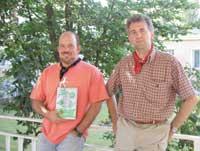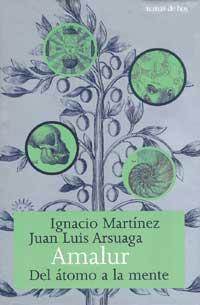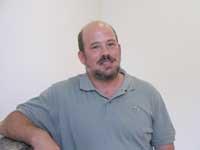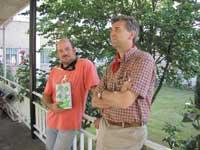Martinez-Arsuaga: "Writing feels a great concern for the reader"
In the title you choose the word Amalur and the hypothesis Gaia is mentioned at the end of the book. To what extent do both have to see?
I. Martinez: Yes, they have to see, but our book is alternative because it is written from a much more materialistic perspective. The subject is somewhat mystical and we did not want to use it. But we wanted to speak and that's why we chose Amalur.
The book presents theories on many subjects (evolution, extraterrestrial life, …). How far do you support a theory?

I. M.: Once presented all the theories, we give our opinion. In the case of extraterrestrial life, for example, the reader asks us for our opinion. That is why it seems to me very good technique to present what there is and, once finished, give our opinion. We are also portrayed in Darwin's chapter.
How have you collected the necessary information to make a book of these characteristics? Do you have enough time to do so?
I. M.: There is work of the nights and besides many years. The information is collected as you learn in different fields. Geology, biology and chemistry are topics that we love a lot and that we speak a lot about among ourselves. At first you should start with an approximate idea of a topic. For example, if you decide to write with entropy, information should be collected about it. He must be fully convinced of this. He feels very worried about the reader. The reader trusts in the writer: the counted must be correct.
You have to collect many data. For example, the radio of the hydrogen atom is given in the book. Finding this data is very difficult: there are problems to know what ionic radio is, so it is not given in many books. You have to understand the problem before writing the data. For that reason, the writer knows much more than written, of course, but we must leave many things without mentioning.
J. L. L. Arsuaga: In addition, all day there is time to think, the mind does not necessarily need rest. The heavier thing is to write and for it you have to look for time.
You have compared entropy with the economy. But comparison only serves to a certain extent. Is it not quite dangerous to use such metaphors in dissemination?
I. M.: Metaphors are very dangerous. If it is used to explain a specific idea, you have to be very careful to spread it. Therefore, we use it for a few ideas and we also warn the reader. We tell you that we will use an analogy. This is learned in class: using metaphors, students only have metaphors.
How did you think of comparing Darwin with Oedipus?

J. L. L. A. A. A theory affirms that literature and theatre are based on a few arguments. These arguments are constantly used and one of them is that the character seeks a response, but he doesn't really want to know the answer. It is the history of Oedipus. And fiction continues to use this approach.
Edipo tries to find out who has killed Layo and begins to investigate. It is a story of great dramatic force: as things become clear, Oedipus is getting worse and worse. In the end he is the murderer.
In part, that also happened to Darwin. He was investigating things he did not like. If they were all as big as he… He accepted things as they came to him. Like it or not, those were the consequences: it is a price to pay.
Since he came from Beagle he was sick. He had some illness, but also suffered a lot psychologically. He had a bad relationship with his father and an extreme anguish with religion.
He was a very curious man, right? He has a very juicy biography…
J. L. L. A. A. He was an adventurer of the time. Darwin wrote the diary of a naturalist and had a great success. If it were not for the theory of evolution, he would be known for his travel books. He was a very brave man. Recently, in a study, a student wrote that he had awarded a scholarship to Darwin to travel aboard the Beagle.
In the book you have focused on the degree of development of the animal nervous system. For example, amphibians and fish have a very simple brain. Is there a lot of difference between them and, for example, the dog?
J. L. L. A. A. Amphibians and fish are almost machines, it can be said that they are robots. Biotechnology is pure. I don't think they have many perceptions: they don't have the brain ready for it. They have no access to subjective experiences. That is consolable for fishermen. It can be questioned that they feel something, including pain. Your brain is a biological tool that processes information and responds to stimuli, but it is not enough for experiences.
And from there, what animals have subjective perceptions? Where is the biological limit?

J. L. L. A. A. It is very difficult to say, in biology there are no clear limits. But I think a dog has awareness of perception, feels pain and joy. However, no one has shown it. Because it cannot be demonstrated. But in 94% of the genome we match the dog, is this big difference in another 6%? I think it is very difficult to say.
I. M.: There is no limit of consciousness to not being. These things are diffuse in biology. This also happens in human evolution. It is very difficult to find limits between hominids and other primates. This change was not sudden.
Recently we have read a new information about this: A skull discovered in Chad, about 7 million years old. Do you know him?
I. M.: Yes, a year ago they found themselves and now the results of the research have been published. There is no hominid light, but that fossil is the closest bone to the time when we separate from the chimpanzees. It may not be the ancestor of chimpanzees and humans, perhaps it is not in the branch of the hominids, but it is the closest fossil at the time of the separation of both branches. I think it won't be far from that point. It is very close to the crossing and that is why it is important.
In the book Amalur, in addition to evolution, they have explained many fields of science, including chemical physics. Does intercaling this type of topics not pose the risk of boring the reader?
J. L. L. A. A. To a certain extent, this frightens and distances the reader, but I think it is essential to count well what we want to count.
How did they meet?
I. M.: I studied biology and my professor of paleontology was Emiliano Agirre. Thanks to him I first came to excavate in Atapuerca. Here, in 1984, I met Juan Luis (Arsuaga). As we were doing very well, I asked him to be the director of my thesis. Since then our history is known.
In what fields were they working in 1984?

I. M.: That year we began to systematically excavate the site of La Sima de los Huesos. A year earlier, a sampling was conducted in which some human fossils were extracted. Juan Luis and I worked there, together with two other friends, in total we were four.
The Gran Dolina began excavating a little in 83, but very little. At the beginning of the thesis we worked in both places, in the morning in one and in the afternoon in the other. But then we did all the work in Sim.
Is it the most important of the two deposits?
I. M.: I think the Sima de los Bones is even more useful. From Gran Dolina we get the traces of man, but in the other one you can investigate many more things. Our article on La Sima is among the best articles of paleontology.
J. L. L. A. A. In Gran Dolina we have found the oldest remains, but the oldest is not always the best. For me, for example, the transition between Neanderthal and Cro-Magnon is much more interesting, even more modern. But, in short, the importance of a topic depends on the value that society gives it.
Buletina
Bidali zure helbide elektronikoa eta jaso asteroko buletina zure sarrera-ontzian











